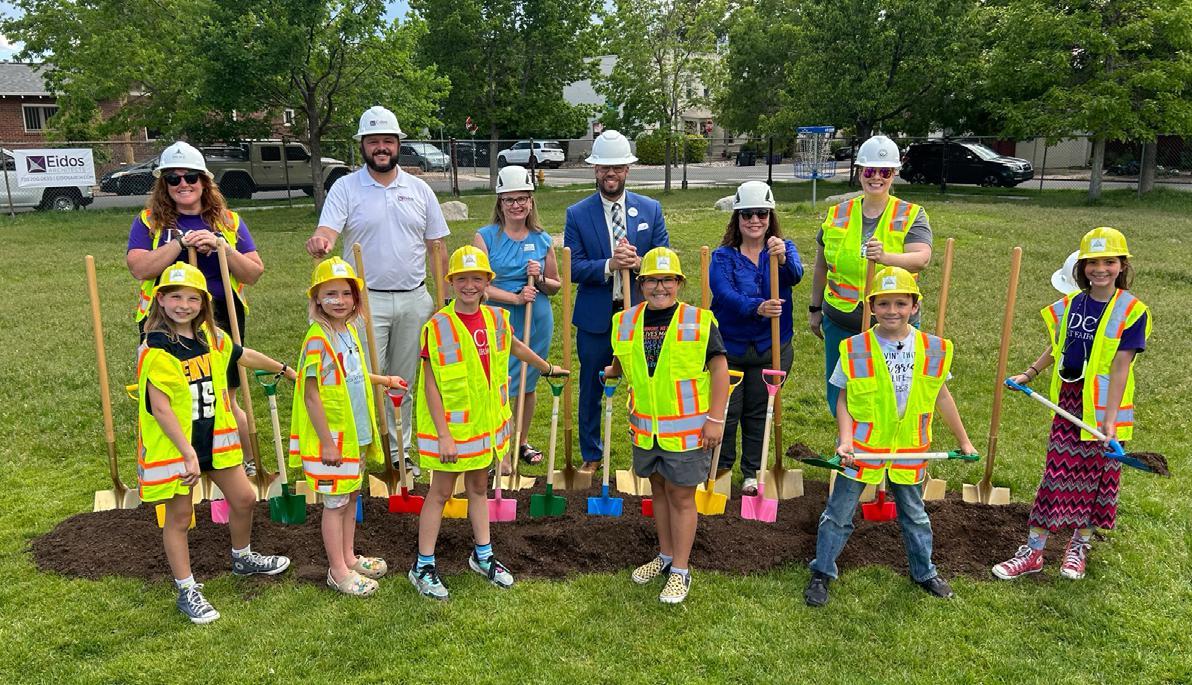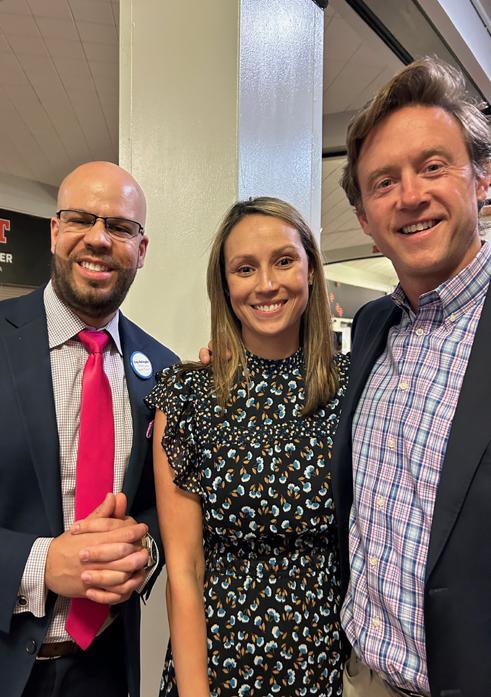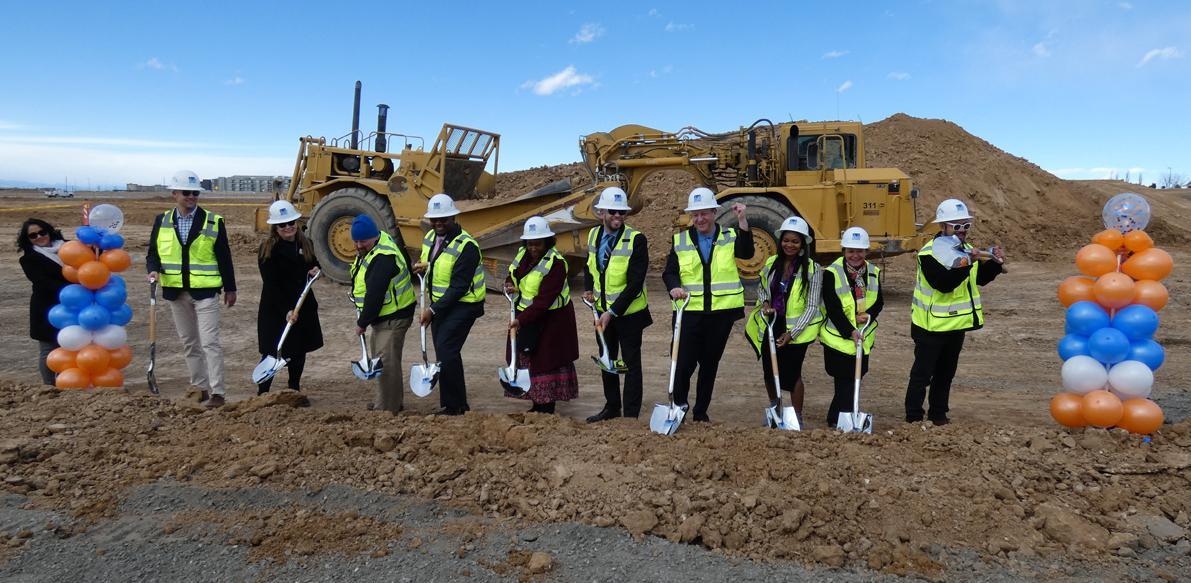
Scan to view the interactive version


Scan to view the interactive version

Dear Members of the DPS Community,
As we progressed through our Capital Planning process, transparency, inclusivity, and community engagement remained at the heart of our work. The investments we make in our schools are designed to shape the educational experiences of our students for years to come, and we remain committed to ensuring that every decision reflects the values, needs, and voices of those we served.
A clear and structured process was essential in making thoughtful, equitable, and fiscally responsible choices. By prioritizing open communication, community involvement, and accountability, we built trust and confidence in how resources were allocated. This five-phase process—rooted in collaboration between district leaders, educators, families, and the broader community—ensured that every project was carefully assessed, aligned with our strategic priorities, and responsive to the evolving needs of our students.
Our commitment to transparency meant that we provided ongoing updates, opportunities for feedback, and a clear rationale behind every decision. We understand that when our families, educators, and community members actively participate in shaping these plans, the outcomes are stronger, more sustainable, and better suited to the needs of all students.
Thank you for your partnership and engagement throughout this process. Together, we laid a stronger foundation for the future of Denver Public Schools.
In Collaboration,
Dr. Alex Marrero Superintendent, Denver Public Schools

A Special Thank You to our DPS Board Members:
Dr. Carrie A. Olson
President and Board Director, District 3
Marlene De La Rosa
Vice President and Board Director, District 5
Kimberlee Sia
Treasurer and Board Director, District 1
John Youngquist
Secretary and Board Director, At Large
Scott Esserman
Board Director, At Large
Xóchitl Gaytán
Board Director, District 2
Michelle Quattlebaum
Board Director, District 4
A special thank you to the Capital Planning Team for their expertise in facilities planning and academic outcomes, for ensuring a thoughtful and fiscally responsible approach, and for providing critical insights to guide responsible decision-making. The Community Planning Advisory Committee (CPAC) played a key role in gathering community input, refining project priorities, and creating a bond package ultimately approved by the Board of Education.
The success of the Capital Planning process was made possible by the dedication and collaboration of district leaders, teams, and community partners. A commitment to transparency, strategic investment, and community engagement drove this work. We deeply appreciate the contributions of everyone involved—district leaders, staff, and community members—who came together to ensure this process reflected the needs and priorities of our students, families, and stakeholders. Your partnership has helped set a strong foundation for Denver Public Schools’ future.
Internal Contributors:
Melissa Rosales McCall, Senior Program Manager, Board & Community Planning
Chuck Carpenter, Chief Financial
Officer
Trena Marsal, Chief Operating Officer
Assistive Technology
Business Diversity
Choice & Planning
Facility Management
Finance
Planning, Design & Construction
Safety
Strategic Sourcing
Technology Services

This toolkit was developed to document Denver Public Schools’ successful journey in planning and executing a bond initiative to improve schools and infrastructure. It serves as a guide for district leaders and stakeholders in other communities who aspire to replicate this work. By sharing key strategies, tools and insights, we aim to provide actionable guidance for creating impactful capital plans tailored to local needs.
This resource is organized into five phases that reflect the core components of our planning process. Each phase includes:
• Actionable Strategies: Steps taken to engage stakeholders, evaluate projects and build community trust.
• Key Activities and Outputs: Practical details about what was done and what was produced.
• Insights for Success: Reflections on the elements that contributed to each phase’s effectiveness.
Additionally, you’ll find tools and resources to support each phase, offering practical templates and examples to help you adapt these approaches to your district.
• District Leaders and Administrators: To understand the high-level strategy and operational steps involved.
• Community Stakeholders: To see how inclusive planning can result in equitable, impactful outcomes.
• Project Managers and Teams: To access practical tools and frameworks for organizing and executing similar initiatives.
• Start with the Phase Pages: These sections provide a step-by-step guide to replicating key parts of our process.
• Leverage the Tools and Resources: Use the included templates and examples as starting points or inspiration.
• Adapt for Your Community: Every district is different. Customize these strategies to reflect your community’s needs, goals, and priorities.
If you have any questions or need further information, please contact us at bond@dpsk12.net or visit ourwordourbonddps.org. We’re happy to provide additional insights or resources to support your efforts.
PHASE 2 (PG. 10)
Internal Project Prioritization and Decision-Making

PHASE 1 (PG. 7)
Planning and Vision
PHASE 4 (PG. 16)
Informing and Socializing the Bond Package
PHASE 3 (PG. 13)
Community Input and Finalization

Phase 1 establishes the groundwork for a successful capital planning process by aligning stakeholders and defining strategic priorities. This phase focuses on fostering collaboration and generating initial project ideas that align with the district’s long-term goals.
A key step in this phase is the formation of the Large Capital Planning Prioritization Group, which includes representatives from diverse district functions, such as safety, technology and facilities maintenance. This group ensures that input reflects all major areas of the district’s operations. Their feedback shapes early priorities while leaving room for broader community input in later phases.
To kick off the process, roles and responsibilities are assigned to stakeholders, who include district leaders, department representatives and staff involved in capital planning. A kickoff meeting establishes goals and processes while fostering an environment for collaboration. Early brainstorming sessions are guided by a comprehensive communication plan designed to ensure transparency and engagement.
• Identifying and aligning stakeholders by determining their roles and responsibilities, including representatives from district leadership, facilities, finance and community engagement teams.
• Establishing the Large Capital Planning Prioritization Group to provide input on project ideas, ensuring diverse district functions such as safety, technology and maintenance are represented.
• Conducting kickoff meetings to introduce the planning process, outline goals and foster collaboration among participants.
• Facilitating brainstorming sessions to generate an initial list of project ideas, drawing on stakeholder insights to ensure a broad and inclusive starting point.
• Developing a communication strategy to maintain transparency and keep stakeholders informed through regular updates and clear messaging.
Successful/Effective capital planning starts with a strong foundation of district priorities, policies, and data. The following inputs—such as strategic roadmaps, stakeholder roles, and community feedback—help shape the key activities in this phase, ensuring decisions are well-informed, strategically aligned, and grounded in real-world considerations.
District Strategic Roadmap
Ensures capital planning aligns with overarching district goals.
District Board Policies
Ensures capital planning aligns with overarching governance structures, and board priorities.
Previous Bond or Capital Plans (if applicable)
Reference materials from past initiatives to inform scope, gaps, and lessons learned.
Existing Community Feedback
whether gathered through past engagement efforts, surveys, or advisory committees—provides critical insight into what families, students, and staff want to see improved in their schools. Incorporating these perspectives early ensures the bond initiative reflects real needs, builds trust, and prioritizes projects that have strong public support.
Demographic & Enrollment Data
Helps assess long-term facility and infrastructure needs.
Stakeholder Landscape & Roles
Identifies key decision-makers, departments, and partners involved in the planning process.
State or Local Regulations & Compliance Requirements
Outlines legal and funding considerations that influence planning decisions.


• Defined roles and responsibilities for all stakeholders, ensuring clarity and accountability throughout the process.
• A preliminary list of potential capital projects aligned with district goals, created through collaborative brainstorming and stakeholder input.

• A framework for prioritizing projects, including a clear set of criteria to guide evaluations in later phases.


• A detailed communication plan, outlining methods and timelines for keeping all stakeholders — initially internal teams, later expanding to community representatives — informed and engaged.














Success in Phase 1 relies on creating a strong foundation built on collaboration, clear communication and strategic alignment. Early and intentional engagement with stakeholders is critical to building trust and fostering a sense of shared ownership. By clearly defining roles and responsibilities from the start, participants can focus their efforts effectively and avoid confusion later in the process.
Additionally, a thoughtful communication strategy ensures transparency and keeps all stakeholders aligned with the district’s vision. Open and inclusive brainstorming sessions provide the opportunity to explore a wide range of project ideas, setting the stage for meaningful prioritization in later phases. By prioritizing inclusivity, clarity and trust, this phase ensures that the planning process begins on solid ground.


Before engaging the broader community, the district must take a deep dive into proposed projects, ensuring each one is thoroughly vetted, financially feasible, and strategically aligned. This internal phase is essential for refining the “why” behind each project, so that when the final recommendations are presented to the community, they are well-supported, clearly prioritized, and realistic within available funding constraints.
The process begins with internal district teams, including finance, facilities, and instructional leaders, assessing and prioritizing potential projects based on district goals, feasibility, and community impact. Subcommittees evaluate project scopes, conduct cost analyses, and ensure alignment with long-term educational and infrastructure needs. Through multiple rounds of internal review, the district finalizes a structured, well-supported set of recommendations before engaging the Community Planning Advisory Committee (CPAC) and the broader public.
This approach prevents projects from being introduced prematurely, ensuring that only wellvetted, mission-critical proposals reach the community for input.






• Refining project proposals through cross-departmental collaboration, ensuring alignment with district priorities and long-term strategic plans.
• Conducting cost analyses to assess feasibility and create clear funding parameters.
• Prioritizing projects internally using structured evaluation criteria to ensure the most impactful initiatives move forward.


• Developing justifications and rationale for each recommended project, ensuring transparency in later community discussions.

• Preparing for leadership review to confirm alignment before engaging the CPAC and broader community.











District Strategic Roadmap & Board Policies
Ensures project prioritization aligns with long-term district goals, governance structures, and policy requirements.
Facility Condition Assessments & Infrastructure Reports
Provides data on existing school facilities, identifying urgent needs and long-term capital priorities.
Educational Program & Instructional Needs
Ensures that proposed projects support academic priorities, student learning environments, and future programming needs.
Cost Estimates & Financial Feasibility Analyses
Establishes funding constraints, allowing for informed decision-making on project scope and prioritization.
Prioritization Rubrics & Equity Indices
Stakeholder Input from Earlier Phases
Guides internal teams in assessing projects based on impact, feasibility, equity, and alignment with district objectives.
Incorporates feedback from district leadership, schoolbased teams, and previous engagement efforts to refine project recommendations.
Legal & Regulatory Considerations
Ensures all selected projects comply with state and local requirements, funding regulations, and accessibility guidelines.


• A structured, vetted list of recommended projects ready for community engagement.

• Clear financial and funding guardrails to guide decisions and public discussions.
• Documentation of project justifications outlining the strategic importance and long-term impact of each proposal.


• Leadership-reviewed recommendations that set the foundation for transparent community decision-making.







The success of this phase depends on thorough internal vetting before any community engagement begins. By taking the time to refine projects, ensure financial feasibility, and develop clear justifications, the district enters community discussions with confidence, clarity, and a well-supported proposal. This approach builds trust with stakeholders and ensures that public feedback is focused on enhancing well-developed projects, rather than debating their fundamental necessity.

With a fully vetted package of prioritized projects, the district now turns to external stakeholders for review and input. This phase ensures that the Community Planning Advisory Committee (CPAC) and broader community have a meaningful opportunity to assess, refine, and validate the proposed bond package before finalization.
At this stage, the CPAC—comprising community representatives, district stakeholders, and subject matter experts—reviews the internally developed recommendations. Their role is to evaluate project priorities, provide feedback, and ensure that community needs are reflected in the final package. Structured discussions, public meetings, and engagement opportunities allow CPAC members and the broader public to ask questions, voice concerns, and propose refinements.
The district facilitates transparent discussions, ensuring that community feedback is incorporated while maintaining financial feasibility and strategic alignment. This process strengthens public trust and increases the likelihood of broad support for the bond initiative.




• Presenting the vetted project list to CPAC and the public for feedback and validation.
• Facilitating structured discussions to ensure alignment between district priorities and community expectations.


• Documenting community recommendations to inform final refinements.
• Addressing concerns and providing clarity on the rationale behind project selections.










CPAC Creation & CPAC Chair Assignment
Sub-Committee Creation
Establishes a representative committee with clear leadership to facilitate discussions and guide the community review process.
Focuses on specific project areas to ensure detailed evaluation and expertise-driven recommendations that align with district goals.
Public Comment and Surveys
Provides a structured opportunity for community members to offer feedback, ensuring diverse perspectives are reflected in the final bond package.
Board of Education Engagement
Ensures alignment with district policies and priorities, while providing transparency and opportunities for feedback and guidance.
Media Engagement
Keeps the broader community informed through press releases, social media, and other channels to reinforce transparency and build trust.
Meeting Facilitation Tools
Agendas, discussion guides, and protocols for structured conversations to keep community engagement productive and focused. Slide decks, infographics, and project visuals also help simplify complex information for community members.




• A refined and community-vetted bond package, incorporating CPAC and public input.
• Meeting summaries and feedback reports that document key discussions and refinements.

• A clear public engagement record demonstrating transparency in decision-making.
• Final recommendations for Board of Education review before the package is officially adopted.













Success in this phase is measured by the quality and depth of community engagement. A wellstructured CPAC process ensures that public input is meaningful, transparent, and results in refinements that strengthen the bond package. By the end of this phase, the bond proposal should reflect both district priorities and community needs, setting the stage for final Board approval and public advocacy.


With the bond package finalized and approved through both internal and external review, the focus now shifts to ensuring clarity and transparency. This phase is about informing, educating, and answering questions—not campaigning or advocating for a particular outcome. The goal is to make sure that anyone interested in learning about the bond package understands what it includes, why these projects were selected, and how decisions were made.
During this phase, district leadership, including the Superintendent, Board of Education, and key district staff from earlier phases, take an active role in presenting the bond package. They engage with various audiences—legislators, schools, community organizations, and other stakeholders— through meetings, presentations, and public forums. These efforts ensure that the process and rationale behind the package are well understood by all key stakeholders.
Importantly, this phase unfolds over several months, beginning in the summer and continuing until November elections. The long timeline allows for ongoing engagement and transparency, reinforcing trust in the process.
• Presenting the bond package to a variety of stakeholders, including schools, community groups, business organizations, and policymakers.
• Hosting Q&A sessions where district leadership provides clear, factbased explanations of the bond process and project selection.
• Ensuring consistency in messaging so that all district employees engaged in presentations share the same information.
• Providing public-facing materials (fact sheets, FAQs, slide decks) to help explain the bond package in an accessible way.
Finalized Bond Package & Project List
Provides a clear, board-approved set of projects (and associated budgets) to be communicated consistently across all audiences.
Messaging Framework & FAQs
Ensures district leaders and staff have aligned key messages and answers to common questions about the bond package.
Presentation & Outreach Materials
Slide decks, fact sheets, and talking points designed to support meetings with schools, community groups, and policymakers.
Engagement Schedule & Audience List
Outlines planned presentations, meetings, and outreach efforts to ensure broad community awareness.
Tracking & Feedback Mechanisms
Tools for recording common questions, concerns, and areas needing additional clarification to refine messaging.
• A clear, well-communicated bond package that is understood by all key stakeholders.
• Presentation materials and FAQs that ensure consistency in messaging across different audiences.
• Meeting and engagement records documenting the questions and concerns raised, helping to track areas where additional clarity may be needed.
• Stronger public trust and understanding, reinforcing the transparency of the process.
This phase is successful when stakeholders feel informed and confident in their understanding of the bond package. By providing structured, fact-based communication, district leaders ensure that the community has a clear picture of what the bond will support and how it was developed. The emphasis on transparency and accessibility, rather than advocacy, helps maintain trust and ensures that the process remains focused on educating rather than persuading.



uring transparency and maintaining public trust doesn’t end once the bond package is finalized— it is an ongoing commitment. The community expects regular updates on how bond dollars are being spent, what progress is being made, and how the approved projects are benefiting students and schools.
DPS uses multiple channels to keep the public informed, including the bond website, newsletters, public meetings, and reports to the Board of Education. These efforts help reinforce trust, provide accountability, and demonstrate the impact of the bond over time.
One of the most effective ways to sustain transparency is through the establishment of a Bond Oversight Committee—an independent group responsible for monitoring expenditures, tracking project progress, and ensuring that bond funds are used as intended. While this is not a requirement, many districts find it to be a valuable tool for ensuring accountability and building long-term public confidence.
• Regular Public Updates: Maintain a central bond website with project updates, financial reports, and timelines.
• Community Engagement: Continue hosting public forums, schoolbased meetings, and updates to key stakeholders.
• Oversight & Accountability: Consider forming a Bond Oversight Committee to track spending and ensure transparency.
• Clear & Consistent Messaging: Use newsletters, infographics, and social media to communicate progress in a way that is accessible to all stakeholders.



Check Out Our Website!
Learn more about the approved bond projects, CPAC, subcommittees, FAQs, and oversight committee

Community Newsletters
Keep up to date with our community newsletters
Check Us Out On YouTube
All of our Bond videos in one place

Projects by Initiative Safe & Welcoming

Watch the Final CPAC Meeting

Pursuit of Passion

Our priorities for the planning committee were simple:

All students and adults feel safe, welcome, and ready to learn
All students have the foundational skills and support to pursue their passion
Apply to Join the 2024 Community Planning and Advisory Committee
We improve our school conditions by leveraging data equitably, sustainably, and strategically
